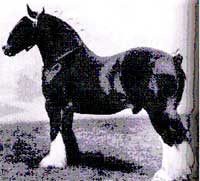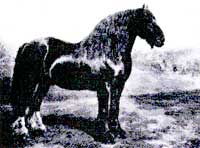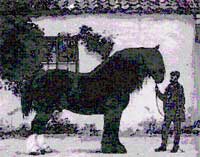| |
The origins of the Shire
are found in ancient time. It seems the Romans already during their
first campaigns in Britain, told about achievements of this huge
and powerful horse. It is told that the Shire had several appellatives
such as great horse, horse of the war, horse of the car or Black
English horse.
.: Ancestor of the shire
.: The development of the breeding
.: The first exports
.: After the First World War
.: Breeding history
.: Historical pictures
ancestor
of the Shire
 The
year 1068 it seems to be the first time there is some talk of the
forefather of the shire like pack-horse. During the reign of King
John, from 1199 to 1216, a hundred stallions of high stature and
great size (Flemish German horse or Belgian draft-horse) were introduced
in England from the present Holland and from the lands of Elba.
From that moment on, more than 8 hundreds years ago, the crossbreed
of these animals with the local English breed gave birth to an English
draft-horse. The
year 1068 it seems to be the first time there is some talk of the
forefather of the shire like pack-horse. During the reign of King
John, from 1199 to 1216, a hundred stallions of high stature and
great size (Flemish German horse or Belgian draft-horse) were introduced
in England from the present Holland and from the lands of Elba.
From that moment on, more than 8 hundreds years ago, the crossbreed
of these animals with the local English breed gave birth to an English
draft-horse.
During the period of time between the reign of Henry II (1154) and
that one of Elizabeth I (from the middle of XVI century) they started
to pay attention to improve the high stature and size, and the character
of the great horse. As a matter of fact Henry VIII, at the end of
the XVI century, introduced the name Shire.
Paintings of the epoch describe these Fleming horses with the majority
cloak black and with white spot on the head and on the feet, often
they had all the feet white up to the hocks. Besides they were high,
slim, muscular, thrust well, with solid articulations and strong
legs that were long-fringed hairy from the clogs to the high part
of the metatarsus and metacarpus.
It was Henry VIII to introduce strict laws to preserve the selection
of this breed; for example it was forbidden to use horses lower
than the 150 cm high in the crossbreed, and it was forbidden the
export of stud mares and stallions, thus restricting the commerce
to the gelding only.
Even though the ancient function of the Shire was the war, in the
XVII century it was discovered much more useful for heavy jobs:
it was precious in the road transport and for works such as reclamation
and in the woods.
(into photo: Clansman,
champion into 1917)
The
development of the breeding
The swampy zones of the counties of Lincoln and Cambridge were the
first to develop the breeding of the Shire that only after started
to spread in the counties of Derby, Norfolk, Nottingham, Leicester
and Huntington that are practically all the Midlands.  Depending
on the origin county, different species of the same breed could
be seen: in fact the horses no more in the birth lands, were inclined
morphologically to being sturdier and with a longer mane; those
of the Yorkshire and the Lancashire instead were well seen for their
incredible resistance. Depending
on the origin county, different species of the same breed could
be seen: in fact the horses no more in the birth lands, were inclined
morphologically to being sturdier and with a longer mane; those
of the Yorkshire and the Lancashire instead were well seen for their
incredible resistance.
Even if the request for these horses increased remarkably, it had
not been yet defined a Breed standard of breed. In the eighteenth
century the improvement of the roads and the increase of the carriage
brought the use of the Shire in the cities. In this period Robert
Bakewell improved the already high Breed standard of this breed,
classifying it like Leicestershire Cart Horse, introducing one line
of blood of the best Dutch horse, the Frisian.
In 1878 the first official registry of SHIRE HORSE SOCIETY was created.
(into photo: Premier
(1880-1892))
The
first exports
In 1836 the first exemplars were exported in Canada, few years after
some more exemplars were exported in the United States, even if
not all the exemplars were enrolled to the English official registry.
In America it was appreciated to point that the request of these
exemplars exceeded the English production so much that the English
were obliged to export exemplars of minor quality.
In 1885 to preserve the purity of the breed the A.S.H.A was instituted.
(American Shire Horse Association) followed by the C.S.H.A. (Canadian
Shire Horse Association) in the 1888. With the beginning of XX century
the Shire saw the greatest diffusion this breed has achieved, overcoming
in importance some other draft-species such as the Percheron. Thanks
to the heavy stature and the reactivity the Shire had a main role
in the American urbanization process, in fact from 1909 to the 1911
6700 exemplary had been registered of which approximately 80% were
native.
After
the First World War
 With
the end of the First World War and the advent of industrialization
the Shire began to be replaced by truck, bus. In the country smaller
and less expensive horses in the maintenance were preferred because
the Shire was replaced in its job by trucks. The draft-Belgian and
the Percheron began to take control of draft-horse markets restricting
the use of the Shire to the zones of the west especially in California. With
the end of the First World War and the advent of industrialization
the Shire began to be replaced by truck, bus. In the country smaller
and less expensive horses in the maintenance were preferred because
the Shire was replaced in its job by trucks. The draft-Belgian and
the Percheron began to take control of draft-horse markets restricting
the use of the Shire to the zones of the west especially in California.
Between 1940 and 1950 the number of the exemplars registered decreased;
between 1950 and 1959 only 25 exemplars were registered. During
the last few years the interest for the Shire had increased thanks
also to the profuse efforts of the Shire Society Horse
(into photo: Castlereagh) |

 Depending
on the origin county, different species of the same breed could
be seen: in fact the horses no more in the birth lands, were inclined
morphologically to being sturdier and with a longer mane; those
of the Yorkshire and the Lancashire instead were well seen for their
incredible resistance.
Depending
on the origin county, different species of the same breed could
be seen: in fact the horses no more in the birth lands, were inclined
morphologically to being sturdier and with a longer mane; those
of the Yorkshire and the Lancashire instead were well seen for their
incredible resistance. With
the end of the First World War and the advent of industrialization
the Shire began to be replaced by truck, bus. In the country smaller
and less expensive horses in the maintenance were preferred because
the Shire was replaced in its job by trucks. The draft-Belgian and
the Percheron began to take control of draft-horse markets restricting
the use of the Shire to the zones of the west especially in California.
With
the end of the First World War and the advent of industrialization
the Shire began to be replaced by truck, bus. In the country smaller
and less expensive horses in the maintenance were preferred because
the Shire was replaced in its job by trucks. The draft-Belgian and
the Percheron began to take control of draft-horse markets restricting
the use of the Shire to the zones of the west especially in California.